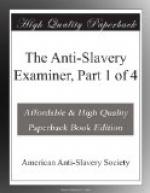[Footnote A: The French follows the same analogy; grandson being petit fils (little son.)]
OBJECTION II.—“If a man smite his servant or his maid with a rod, and he die under his hand, he shall surely be punished. Notwithstanding, if he continue a day or two, he shall not be punished, for he is his money.” Ex. xxi. 20, 21. What was the design of this regulation? Was it to grant masters an indulgence to beat servants with impunity, and an assurance, that if they beat them to death, the offense shall not be capital? This is substantially what commentators tell us. What Deity do such men worship? Some blood-gorged Moloch, enthroned on human hecatombs, and snuffing carnage for incense? Did He who thundered from Sinai’s flames, “THOU SHALT NOT KILL,” offer a bounty on murder? Whoever analyzes the Mosaic system, will find a moot court in session, trying law points—settling definitions, or laying down rules of evidence, in almost every chapter. Num. xxxv. 10-22; Deut. xi. 11, and xix. 4-6; Lev. xxiv. 19-22; Ex. xxi. 18, 19, are a few, out of many cases stated, with tests furnished the judges by which to detect the intent, in actions brought before them. Their ignorance of judicial proceedings, laws of evidence, &c., made such instructions necessary. The detail gone into, in the verses quoted, is manifestly to enable them to get at the motive and find out whether the master designed to kill. (1.) “If a man smite his servant with a rod.”—The instrument used, gives a clue to the intent. See Num. xxxv. 16, 18. A rod, not an axe, nor a sword, nor a bludgeon, nor any other death-weapon—hence, from the kind of instrument, no design to kill would be inferred; for intent to kill would hardly have taken a rod for its weapon. But if the servant die under his hand, then the unfitness of the instrument, is point blank against him; for, to strike him with a rod until he




